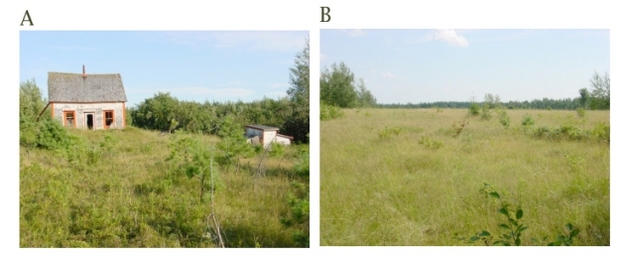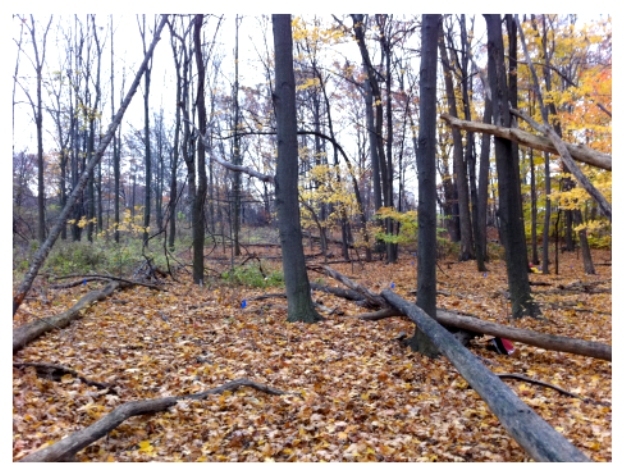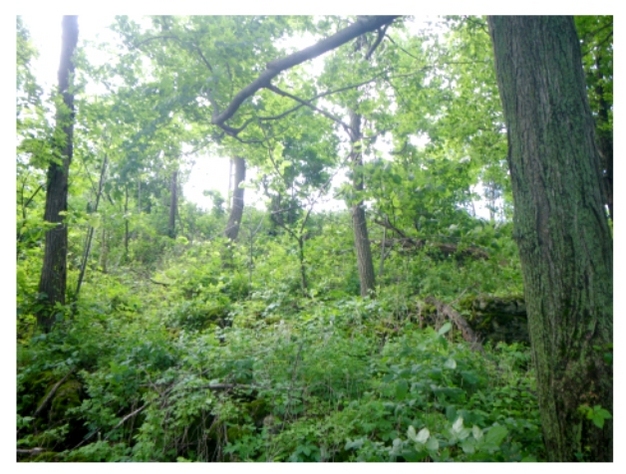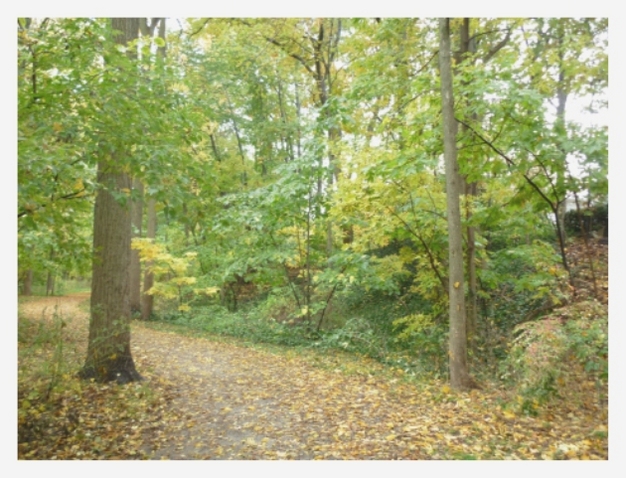« Prev Next »

Deciduous temperate forests are located in the cool, rainy regions of the northern hemisphere (North America — including Canada, the United States, and central Mexico — Europe, and western regions of Asia — including Japan, China, North Korea, South Korea, and parts of Russia). Some smaller areas of deciduous forests can also be found in the southern hemisphere — in South America, Africa, and Australia. They cover 7.8 million km2 worldwide (Allaby 2006). Deciduous forests are unique, as most dominant tree species lose their leaves once a year with changes in climatic /environmental conditions, mainly photoperiod. In the autumn, a reduction in photoperiod causes deciduous trees and some other plants to undergo physiological changes, leading to the cessation of chlorophyll production and senescence of the leaves. During the growing season, conditions are favourable with an average annual temperature of 20oC and ranging between 18 and 30oC (Allaby 2006). Temperatures drop in the autumn, reaching freezing point, or below, during the winter. Mean annual precipitation ranges from 750 to 1500 mm and is spread fairly evenly throughout the year (Allaby 2006).
Historically, deciduous forests have been targeted for logging and land clearing for agricultural purposes, then giving way to urbanization. In Europe, forests have been exploited since prehistoric times for various uses such as wood-pasture, agroforestry, and timber woodland (Bergmeier et al. 2010). Nowadays, in Central Europe, only 1% of the original forest remains (Donoso 1997). Such land uses greatly affect species composition and community structure (Gillet 2008). While some of these practices (e.g., wood-pasture) have been banned almost everywhere since the 1800's, relic sites can be located, suggesting that restoration is slow and limited due to past disturbance and management practices (Bergmeier et al. 2010). In North America, disturbance was limited until European colonization. Logging and agricultural expansion led to a dramatic decrease in deciduous, especially old growth, forests in the 17th through the 19th century. Since 1600, in the United States of America, 90% of the original forests have been logged or exploited by humans (Abramovitz 1998). With changes towards a more urban lifestyle in the 1990's, agricultural lands have been abandoned and left to regenerate through passive restoration (Figure 1). Such changes have brought great opportunities for researchers to examine the process of regeneration of abandoned or clearcut lands, as has been the case with Hubbard Brook Experimental Forest (e.g., Martin & Hornbeck 1990, Hughes & Fahey 1985). Today, North American deciduous forests are fragmented and most patches are isolated due to the sprawl of urban centres and associated transportation systems (Rhemtulla et al. 2007). In Asia, with population growth and use of traditional intensive agriculture, few intact or large forests remain.

Past History and Potential for Regeneration
The main disturbances that have caused the decrease of deciduous forests in the world include clearing for intensive agriculture and logging. Logging is aimed at extracting wood for commercial use, and while partial cuts have sometimes been promoted, both clearcuts and selective cuts have led to the impoverishment of this ecosystem. Clearing for agriculture has had devastating impacts in most regions of the world and, in many cases, natural regeneration is slow or limited due to changes in soil nutrients and hydrological conditions (Cramer & Hobbs 2007, Flinn & Marks 2007).
Research has shown that regeneration of deciduous forests depends not only on past activities or disturbance, but also on the ecosystem dynamics (Cramer 2007). The composition of the regenerating forest will be affected by abiotic and biotic factors influencing seedling establishment, presence and impacts of founder species, level of biodiversity, and dispersal patterns of species. In addition, other abiotic factors, such as microtopography and drainage and inundation regimes, can interact with the other ecosystem components and change the direction of succession (Gardiner et al. 2004).
The intensity and frequency of disturbance in a deciduous forest ecosystem will highly influence the rate and the success of regeneration (Dutoit et al. 2003) (Figure 2). Stands that have experienced limited management systems, such as selective cuts or one time logging, would have a greater potential for passive regeneration than areas where long term and intensive agricultural practice have been maintained for centuries (Dutoit et al. 2003, Stanturf et al. 2009).

Restoration and Management
Restoration has been considered as a viable and often necessary option to help regeneration of temperate forests. In most cases, temperate forests regenerating naturally are of low quality, missing the original level of biodiversity (Dudley et al. 1986). Restoration has become important for various reasons including improving in ecosystem functions and services, facilitating the reintroduction of species originally present in these forests, increasing biodiversity, etc. (Mansourian et al. 1986). Under the scenarios of climate change, it has also been argued that restoration may be necessary to manage the changes occurring under a new climate thus help buffer against potential degradation (Biringer & Hansen 1986).
Natural regeneration (passive restoration) in deciduous forests that have received relatively low levels of disturbance can be encouraged and facilitated. The process of natural regeneration implies that very little action or management efforts will be employed as means for restoration. Passive restoration can be favoured in partially logged or disturbed forests (e.g., stochastic events such as a wind storm, or the ice storm in Canada in 1998). Although it can be argued that most are from secondary succession, soils in these forests have kept most of their original nutrient and hydrological properties and remain favourable for natural regeneration. Passive regeneration can be advantageous in stands small in size and ideally surrounded by original native forests. Their capacity to reach the status of old growth forest may still be slow.
Passive regeneration can be cost effective as management effort is limited. Activities should include long term monitoring to ensure that regeneration processes are progressing as expected, and to detect changes or conditions that may limit restoration. Depending on the results, it may be necessary to initiate some on-site management, such as control of invasive species or fire management. Adaptive management strategies should be carefully considered and be limited to early stages to avoid complications later on (Figure 3).

Disturbed deciduous forests with impoverished soils, a limited seed bank, or genetically degraded forest sites, may require active restoration (Joyce et al. 2001). This process is needed when conditions cannot allow for natural regeneration to occur. Large areas extensively exploited for agriculture, for example, will have very limited capacity to naturally regenerate as only seed dispersal could contribute to the introduction of original species but would be highly limited. Most deciduous seeds require animals for dispersion, which generally avoid such large open areas.
Active restoration will therefore involve the reintroduction of native trees in addition or not of soil improvement. Ideally, species are selected among those that would have been found originally in the area (Fleming et al. 2001). A broad genetic base should be promoted to ensure that the stock is adapted to the planting site (Joyce et al. 2001). Direct seeding and young tree outplanting are the two options for their reintroduction. Direct seeding is commonly used to overcome the lack of dispersal of native species from surrounding forests but, to be successful, it requires close attention to species selection and favourable soil conditions, as rates of seed germination and seedling survival are generally very low (Fleming et al. 2001). Site preparation and seeding technologies, as well as the selection of the species, must be carefully considered prior to direct seeding. Outplanting, being mechanically and resource demanding, should be limited to smaller stands or in regions where conditions do not allow regeneration from seeds.
In impoverished soil conditions, soil amendments are often required prior to other forms of active restoration like tree planting. Quicklime can be used as an amendment to increase soil pH to a level more favourable for native tree growth. In other cases, organic or chemical nutrients have to be added. Organic matter (e.g., compost) can also be used to improve soil stability and hydrological conditions.
Although tree species are usually the main target of forest restoration, in some cases there may be a need for niche regeneration to improve diversity through transplantation or seeding of shrubs and herbaceous plants (Mottl et al. 2006). The species targeted by this approach should include keystone species rather than rare species as the success rate will be greater, thus increasing effectively diversity.
Barriers to Reestablishment
The deciduous forest zone in the Northern Hemisphere is also the main location of large urban and industrial centres. Fragmentation due to transportation and electricity corridors, as well as intensive agriculture and other human activities (e.g., logging), have left a legacy of poorly managed and protected stands. The context in which restoration is being initiated should consider the surrounding environmental conditions and influences. In several studies on pasture regeneration, invasive plant species have been a major challenge, often reducing the capacity of a forest to regenerate. In addition, the homogenization of the surroundings will always limit the possibility of the stand to reestablish completely with native species.
Restoration of deciduous forests may be more complex than in boreal forests because of higher diversity, and slower than in tropical forests due to climate constraints. Studies have shown that effective restoration of deciduous forests will generally require adaptive management and monitoring. Heterogeneity in soil conditions, the history of previous disturbances, as well as the level of isolation of the forest to be restored, are among some of the issues to consider at the site level and these issues will most likely change in time, thus the importance of adaptive management. Effective balance in restoring soil conditions and reintroduction of native species will encourage regeneration, but control against invasive species and herbivory will be required for a stand to move towards a more natural state (Webb et al. 2001). This is especially true for the restoration of forests that are close to urban centres, where the threats of introduction of invasive species is greater (Figure 4). Aubin et al. (2008) have not found evidence that active restoration would lead to faster regeneration of natural forest.

The potential for restoration in deciduous forests has also been affected by atmospheric pollution (ranging from acid deposition to climate change) (Main-Knorn et al. 2009). High concentrations of industrial activities and the influence of atmospheric currents and dominant winds exacerbate the other stresses already impacting forests (Kozlowski 2002). Finally stochastic events, such as windstorms and fires, and the type of management done after such an event, can influence the success and the speed of regeneration; in some instances minimum management with mainly monitoring activities may be the best solution (Jonasova et al. 2010).
Broader Considerations
It is difficult to define what an original old growth forest is nowadays as deciduous forests have been exploited since prehistoric times. Even in North America, where exploitation started later than in Europe, the intensity with which this has occurred means that remnants of original old growth forests are limited. The omnipresence of humans and human activities in most regions of the northern hemisphere, where deciduous forest ecosystems can be found, is so intense that management must take into account external factors such as air pollution and atmospheric deposition. The survival and sustainability of regenerated forests also depends on larger scale conditions. Confounding effects, such as pollution and climate change, have been studied more recently, and will certainly play a role in whether restoration actions can succeed (Chmura et al. 2011). Increased frequency of droughts due to climate change, or any management practices that lead to increased stress, will most likely have serious consequences on forest regeneration and productivity, as well as the species composition that can be maintained in the long term in those regions (Leuzinger et al. 2005). In future, strategies such as adaptive management and the introduction of new forestry techniques, or genetic diversity, may help support restoration efforts.References and Recommended Reading
Abramovitz, J. N. "Sustaining the world's forests," in State of the World 1998, eds. L. Brown et al.(New York, NY: Norton/Worldwatch, 1998) 25-51.
Allaby, M. Biomes of the Earth: Temperate Forests. New York, NY: Chelsea House, 2006.
Aubin, I., Messier, C. & Bouchard, A. Can plantations develop understory biological and physical attributes of naturally regenerated forests? Biological Conservation 141, 2461-2476 (2008).
Bergmeier, E., Petermann, J. & Schröder, E. Geobotanical survey of wood-pasture habitats in Europe: Diversity, threats and conservation. Biodiversity and Conservation 19, 2995-3014 (2010).
Biringer, J. & Hansen, L. "Restoring forest landscapes in the face of climate change," in Forest Restoration in Landscapes: Beyond Planting Trees, eds. S. Mansourian, D. Vallauri & N. Dudley (New York, NY: Springer, 1986) 31-37.
Chmura, D. J. et al. Forest responses to climate change in the northwestern United States: Ecophysiological foundations for adaptive management. Forest Ecology and Management 261, 1121-1142 (2011).
Cramer, V. A. & Hobbs, R. J. eds. Old Fields: Dynamics and Restoration of Abandoned Farmland. Washington, DC: Island Press, 2007.
Donoso, J. A. P. Perspectives on temperate forest management. Proceedings of the XI World Forestry Congress 38, 153-162 (1997).
Dudley, N., Mansourian, S. & Vallauri, D. "Forest landscape reforestation in context," in Forest Restoration in Landscapes: Beyond Planting Trees, eds. S. Mansourian, D. Vallauri & N. Dudley (New York, NY: Springer, 1986) 3-7
Dutoit, T. et al. Dynamique d'une communauté d'adventices dans un champ de céréales créé après le labour d'une prairie semi-naturelle: Rôles de la banque de graines permanente. Écoscience 10, 225-235 (2003).
Fleming, R. et al. " Direct seeding," in Regenerating the Canadian Forest: Principles and Practice for Ontario, eds. R. G. Wagner & S. J. Colombo (Markham, ON: Frtzhenry & Whiteside, 2001) 351-373.
Flinn, K. M. & Marks, P. L. Agricultural legacies in forest environments: Tree communities, soil properties, and light availability. Ecological Applications 17, 452-463 (2007).
Gardiner, E. S., Stanturf, J. A. & Schweitzer, C. J. An afforestation system for restoring bottomland hardwood forests: Biomass accumulation of Nuttall oak seedlings interplanted beneath eastern cottonwood. Restoration Ecology 12, 525-532 (2004).
Gillet. F. Modelling vegetation dynamics in heterogeneous pasture-woodland landscapes. Ecological Modelling 217, 1-18 (2008).
Hughes, J. W. & Fahey, T. J. Regeneration strategies following whole-tree harvest of a northern hardwood forest. Bulletin of the Ecological Society of America 66, 198 (1985).
Jonasova, M., Vavrova, E. & Cudlın P. Western Carpathian mountain spruce forest after a windthrow: Natural regeneration in cleared and uncleared areas. Forest Ecology and Management 259, 1127-1134 (2010).
Joyce, D., Nitschke, P. & Mossler, A. "Genetic resource management," in Regenerating the Canadian Forest: Principles and Practice for Ontario, eds. R. G. Wagner & S. J. Colombo (Markham, ON: Frtzhenry & Whiteside, 2001) 141-154.
Kozlowski, T. T. Physiological ecology of natural regeneration of harvested and disturbed forest stands: Implications for forest management. Forest Ecology and Management 158, 195-221 (2002).
Leuzinger, S. et al. Responses of deciduous forest trees to severe drought in Central Europe. Tree Physiology 25, 641-650 (2005).
Main-Knorn, M. et al. How pollution legacies and land use histories shape post-communist forest cover trends in the Western Carpathians. Forest Ecology and Management 258, 60-70 (2009).
Mansourian, S., Vallauri, D. & Dudley, N. eds. Forest Restoration in Landscapes: Beyond Planting Trees. New York, NY: Springer, 1986.
Martin, C. W. & Hornbeck, J. W. Regeneration after strip cutting and block clearcutting in northern hardwoods. Northern Journal of Applied Forestry 7, 65-88 (1990).
Mottl, L. M., Mabry, C. M. & Farrar, D. R. Seven-year survival of perennial herbaceous transplants in temperate woodland restoration. Restoration Ecology 14, 330-338 (2006).
Rhemtulla, J. M., Mladenoff, D. J. & Clayton, M. K. Regional land-cover conversion in the U.S. upper Midwest: Magnitude of change and limited recovery (1850-1935-1993). Landscape Ecology 22, 57-75 (2007).
Stanturf, J. A. et al. Restoration of bottomland hardwood forests across a treatment intensity gradient. Forest Ecology and Management 257, 1803-1814 (2009).
Webb, S. L., Pendergast, T. H. IV. & Dwyer, M. E. Response of native and exotic maple seedling banks to removal of the exotic, invasive Norway maple (Acer platanoides). Journal of the Torrey Botanical Society 128, 141-149 (2001).






























